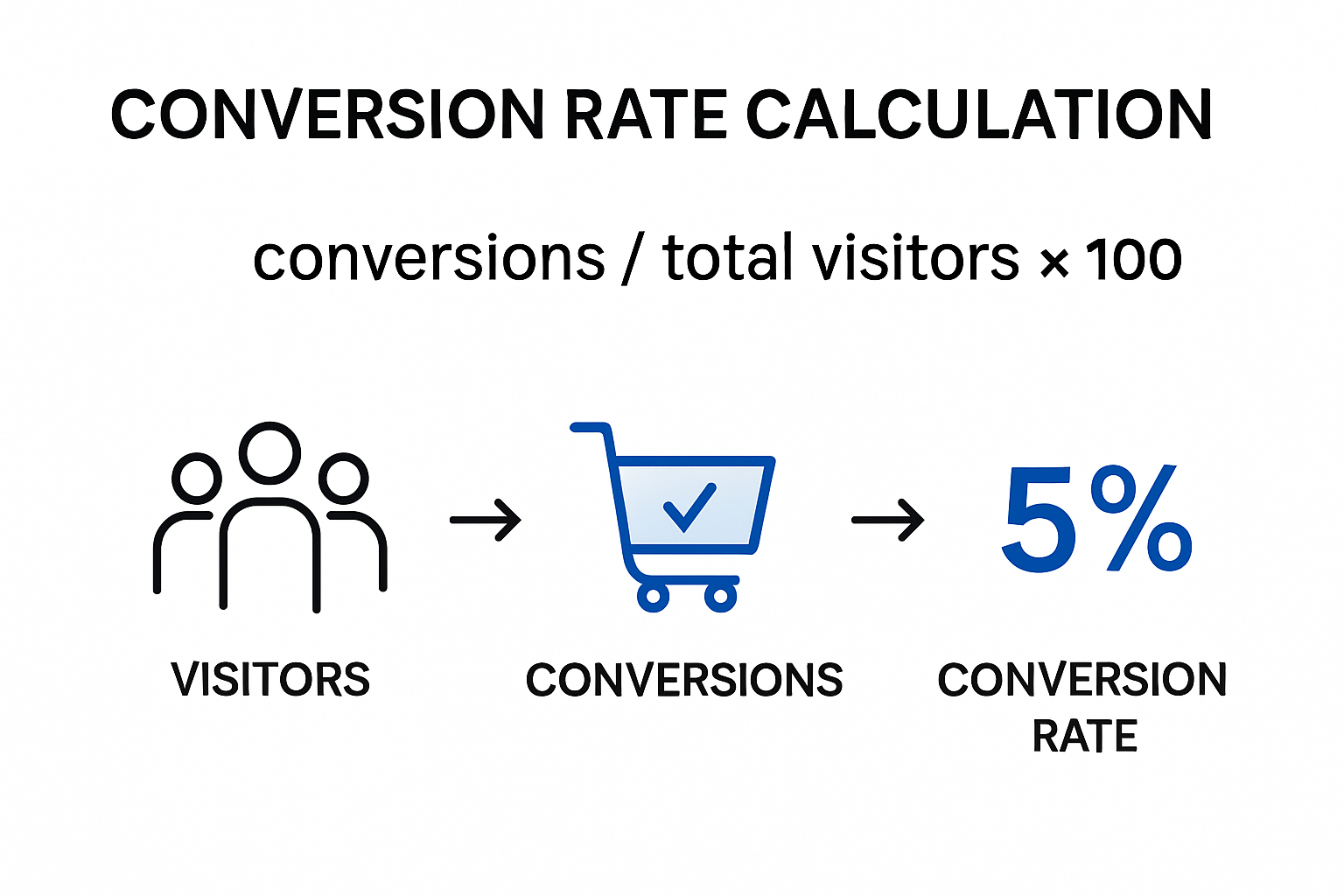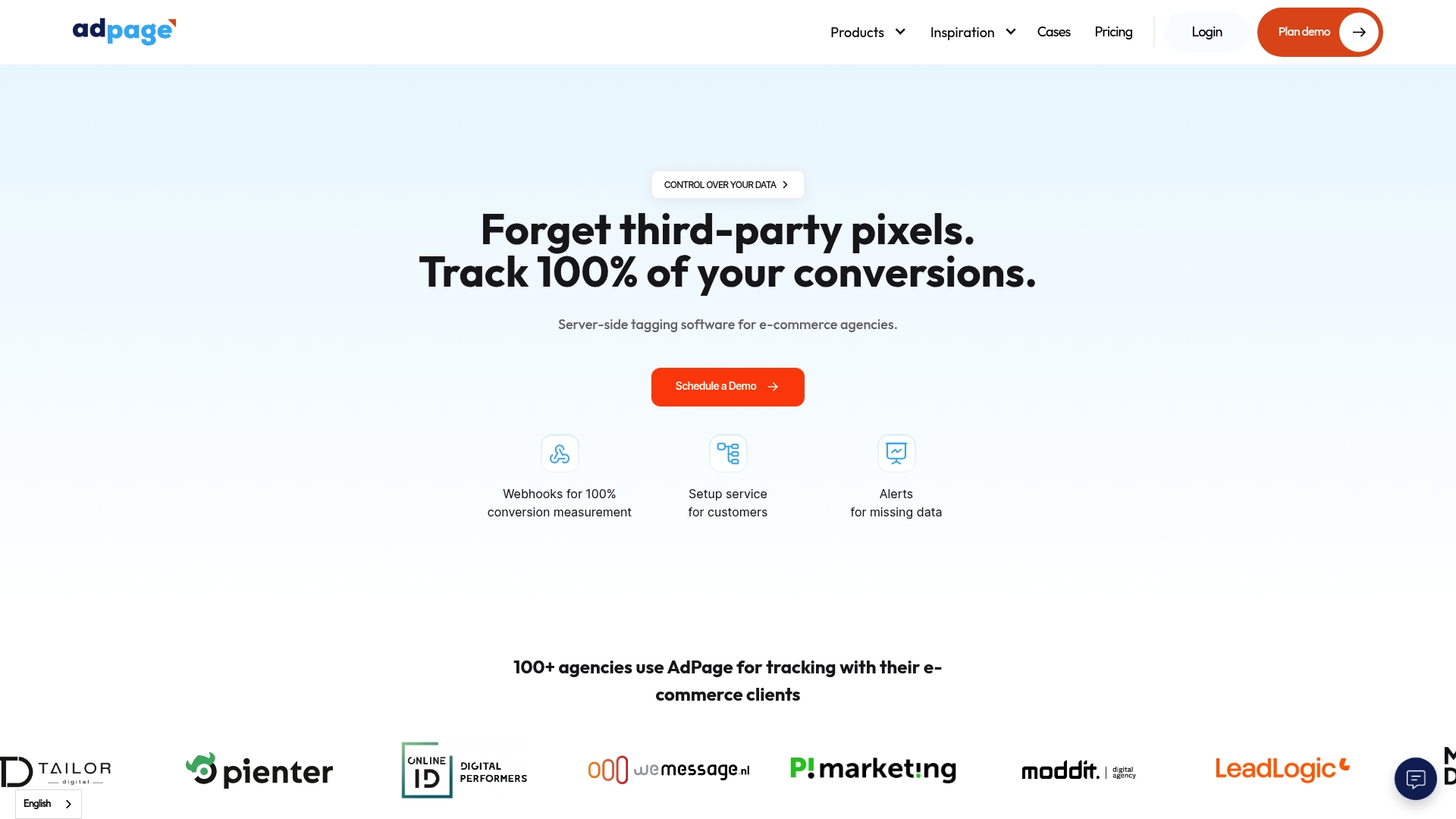E-commerce sites are under pressure like never before as customer expectations skyrocket every year. Here is the twist almost 50 percent of website visitors abandon landing pages without taking any action at all. Yet most businesses focus on chasing more traffic, not realizing that small changes to their site could multiply their results. The secret lies in optimizing what you already have, not just cranking up your ad spend.
Table of Contents
- Understanding Conversion Rate Optimization Essentials
- Key Website Changes To Boost Conversions
- Advanced Data Analytics For Conversion Growth
- Personalization And Automation Strategies For 2025.
Quick Summary
| Takeaway | Explanation |
|---|---|
| Understand Conversion Rates | Conversion rate optimization (CRO) is crucial for transforming website traffic into engagement, and requires deep analysis of user behavior and design elements. By calculating conversion rates (conversions/total visitors x 100), businesses can measure success and identify improvement areas. |
| Prioritize Website Performance | Key performance indicators (KPIs) such as page load speed, user experience design, mobile responsiveness, and content relevance directly influence conversion rates. A delay in load time can reduce conversions significantly, emphasizing the need for quick-loading pages. |
| Implement Continuous Testing | A robust CRO strategy should include continuous testing, analysis, and refinement. Businesses should develop tailored approaches based on empirical data and user insights, enabling incremental improvements in conversion performance. |
| Leverage Advanced Analytics | Sophisticated data analytics techniques, including algorithmic recommendation strategies and predictive forecasting, can dramatically enhance conversion rates by understanding and predicting user behavior. |
| Embrace Personalization and Automation | AI-driven personalization frameworks and intelligent automation are vital for creating tailored experiences that enhance customer engagement and drive conversions. Dynamic and predictive technologies enable businesses to anticipate user needs effectively. |
Understanding Conversion Rate Optimization Essentials
Conversion rate optimization (CRO) represents the strategic process of increasing the percentage of website visitors who complete a desired action. Whether purchasing a product, signing up for a newsletter, or downloading a resource, CRO transforms passive website traffic into meaningful engagement.
The Mathematical Foundation of Conversion Rates
At its core, conversion rate is calculated by dividing the number of conversions by total website visitors and multiplying by 100. For instance, if 1,000 visitors arrive on a website and 30 complete a purchase, the conversion rate stands at 3%. Research from Gostellar indicates that nearly 50% of website visitors abandon landing pages without engaging, highlighting the critical importance of understanding and improving these metrics.

Understanding conversion rates goes beyond simple mathematics. It involves deep analysis of user behavior, website design, and psychological triggers that motivate visitors to take action. Successful CRO requires a comprehensive approach that considers multiple variables simultaneously.
Key Performance Indicators in Conversion Optimization
Effective conversion tracking involves monitoring several crucial performance indicators. Everconnect's study revealed that a one-second delay in page load time can reduce conversions by up to 7%, demonstrating how technical performance directly impacts user engagement.
Critical KPIs for conversion rate optimization include:
- Page Load Speed: Websites must load quickly to prevent user frustration
- User Experience Design: Intuitive navigation and clear call-to-action buttons
- Mobile Responsiveness: Ensuring seamless performance across all device types
- Content Relevance: Providing targeted, valuable information that addresses user needs
To provide a clearer overview, the following table summarizes the key performance indicators and their specific impact on conversion optimization as discussed in the content:
| KPI | Description | Impact on Conversions |
|---|---|---|
| Page Load Speed | How fast website pages load | 1 sec delay can reduce conversions by 7% |
| User Experience Design | Intuitive navigation, clear CTAs | Increases ease-of-use and engagement |
| Mobile Responsiveness | Seamless experience across all devices | Improves satisfaction & conversion rates |
| Content Relevance | Information targeted to user needs | Enhances trust and likelihood of action |
Strategic Approaches to Improving Conversion Rates
Implementing a robust CRO strategy requires continuous testing, analysis, and refinement. This involves creating multiple versions of web pages, understanding user journey maps, and systematically experimenting with design elements, copy, and user interface components.
Successful conversion rate optimization is not about implementing generic best practices but developing a nuanced, data-driven approach tailored to specific audience segments. By combining analytical insights with creative problem-solving, businesses can incrementally improve their conversion performance and transform website traffic into tangible business outcomes.
The most effective CRO strategies integrate quantitative data analysis with qualitative user research, ensuring that optimization efforts are grounded in real user experiences and behavioral insights.
Key Website Changes to Boost Conversions
Optimising website design and functionality represents a critical strategy for improving conversion rates. Strategic modifications can transform user experience, encouraging more visitors to complete desired actions and ultimately driving business growth.
Design and Visual Consistency

Research from the Interaction Design Journal demonstrates that applying structured design strategies through style tiles significantly enhances website usability. Visual consistency plays a crucial role in creating intuitive user interfaces that guide visitors seamlessly towards conversion points.
Key design elements to prioritize include:
- Color Palette: Consistent color schemes that align with brand identity
- Typography: Clear, readable fonts that improve information comprehension
- White Space: Strategic spacing that prevents visual clutter and improves readability
- Visual Hierarchy: Guiding user attention through strategic placement of important elements
Interactive User Experience Enhancements
Human-Computer Interaction research reveals that interactive design elements significantly improve website usability. Implementing dynamic features that respond to user behavior can create more engaging and intuitive browsing experiences.
Effective interactive elements include:
- Hover Effects: Providing immediate visual feedback on clickable elements
- Dynamic Form Validation: real-time guidance during user input
- Personalized Recommendations: Adaptive content based on user preferences
- Quick View Options: Allowing users to preview products without leaving the current page
The table below summarizes the key website enhancement strategies, their examples, and their effect on conversions as detailed in this section:
| Enhancement Area | Example Feature | Effect on Conversions |
|---|---|---|
| Visual Consistency | Color Palette, Typography | Builds trust and improves clarity |
| Visual Consistency | White Space, Visual Hierarchy | Improves navigation and user focus |
| Interactive Experience | Hover Effects | Increases engagement and interactivity |
| Interactive Experience | Dynamic Form Validation | Reduces errors, boosts completion rates |
| Interactive Experience | Personalized Recommendations | Increases relevance and purchase likelihood |
| Interactive Experience | Quick View Options | Speeds up decision-making |
| Mobile Optimization | Responsive Design, Touch Interface | Improves user experience on mobile devices |
| Mobile Optimization | Accelerated Pages, Simple Checkout | Reduces abandonment, increases conversions |
Mobile Optimization Strategies
East Asian Scientific Journal research highlights that mobile optimization directly correlates with improved customer satisfaction and conversion rates. With increasing mobile internet usage, creating responsive designs becomes paramount for e-commerce success.
Critical mobile optimization approaches include:
- Responsive Design: Ensuring seamless display across different device sizes
- Touch-Friendly Interface: Large, easily tappable buttons and navigation elements
- Accelerated Mobile Pages: Implementing lightweight page designs for faster loading
- Simplified Checkout Process: Reducing form fields and simplifying mobile transaction flows
Successful website conversion optimization requires a holistic approach that combines aesthetic design, technical performance, and user-centric functionality. By continuously testing and refining website elements, businesses can create digital experiences that not only attract visitors but effectively guide them towards desired actions.
Advanced Data Analytics for Conversion Growth
Data analytics has evolved from simple reporting to sophisticated predictive and prescriptive strategies that can dramatically transform conversion performance. Modern e-commerce businesses now leverage advanced analytical techniques to understand, predict, and influence user behavior with unprecedented precision.
Algorithmic Recommendation Strategies
Research from ArXiv reveals groundbreaking insights into Multi-Armed Bandit (MAB) algorithms, demonstrating their potential to revolutionize content recommendations. By implementing dynamic algorithmic approaches like Thompson Sampling and Upper Confidence Bound, businesses can achieve remarkable performance improvements, including a 6.13% increase in click-through rates and a 16.1% increase in conversion rates compared to traditional methods.
Key algorithmic recommendation techniques include:
- Contextual Bandits: Adapting recommendations based on real-time user context
- Reinforcement Learning: Continuously improving suggestion accuracy
- Probabilistic Matching: Connecting users with most relevant content
- Adaptive Exploration: Balancing between exploring new recommendations and exploiting known successful patterns
Predictive Demand Forecasting
Advanced Neural Network Research demonstrates how Long Short-Term Memory (LSTM) neural networks can capture complex, non-linear demand relationships within product assortments. These sophisticated models enable businesses to develop highly accurate sales predictions, optimising inventory management and strategic planning.
Predictive analytics strategies encompass:
- Time Series Analysis: Understanding historical sales patterns
- Machine Learning Models: Identifying subtle demand indicators
- Seasonal Trend Recognition: Anticipating fluctuations in consumer behavior
- Anomaly Detection: identifying unusual market signals
Visual Performance Analytics
Comprehensive Analytics Research highlights the emergence of advanced visual analytics systems like LiveRetro, which enable businesses to conduct retrospective analyses of complex performance metrics. These systems provide multi-level insights, allowing organizations to align performance features with user feedback and make data-driven strategic decisions.
Advanced visual analytics approaches include:
- Interactive Dashboards: real-time performance visualization
- Correlation Mapping: Understanding relationships between different metrics
- Predictive Trend Identification: Forecasting potential future performance
- Granular Segmentation: Breaking down performance by user groups
Successful data analytics for conversion growth requires a holistic approach that combines sophisticated algorithmic techniques, predictive modeling, and comprehensive visual interpretation. By integrating these advanced strategies, businesses can transform raw data into actionable insights that drive meaningful performance improvements and sustainable growth.
Personalization and Automation Strategies for 2025.
Personalization and automation represent transformative approaches for e-commerce businesses seeking to deliver exceptional customer experiences and drive conversion rates. By leveraging advanced technologies and intelligent systems, organizations can create highly tailored interactions that resonate with individual user preferences and behaviors.
AI-Driven Personalization Frameworks
Research from ResearchGate demonstrates how AI-powered personalization strategies can dramatically enhance customer engagement by analyzing complex behavioral insights. These sophisticated systems parse browsing histories, purchase patterns, and contextual data to generate hyper-targeted experiences.
Key AI personalization strategies include:
- Predictive Product Recommendations: Generating contextually relevant suggestions
- Dynamic Content Adaptation: Modifying website elements based on user profiles
- Behavioural Segmentation: Categorizing users into nuanced preference groups
- Real-Time Personalization: Adjusting experiences instantaneously during user interactions
Advanced Recommendation System Technologies
Cutting-Edge Machine Learning Research reveals groundbreaking developments in recommendation system technologies. Large language models now enable deeper understanding of user preferences, allowing for unprecedented levels of personalized product suggestions.
Innovative recommendation approaches encompass:
- Contextual Understanding: Interpreting subtle user intent signals
- Multi-Modal Learning: Integrating diverse data types for comprehensive insights
- Preference Clustering: Identifying intricate user preference patterns
- Adaptive Recommendation Algorithms: Continuously refining suggestion accuracy
Intelligent Automation Deployment
Content Optimization Research highlights the potential of real-time, whole-page personalization frameworks. These advanced systems can dynamically optimize content carousels, significantly improving user engagement and conversion potential.
Strategic automation deployment techniques include:
- Automated Customer Segmentation: Dynamically categorizing user groups
- Intelligent Workflow Triggers: Initiating personalized interactions automatically
- Predictive Customer Journey Mapping: Anticipating user navigation patterns
- Contextual Communication Optimization: Tailoring messaging across touchpoints
Successful personalization and automation strategies require a sophisticated approach that balances technological capability with genuine user understanding. By integrating advanced AI technologies, machine learning algorithms, and intelligent automation systems, businesses can create deeply resonant digital experiences that not only meet but anticipate user needs.
Frequently Asked Questions
How can I improve my e-commerce conversion rates in 2025?
To improve e-commerce conversion rates in 2025, focus on conversion rate optimization (CRO) strategies that include analyzing user behavior, enhancing website design for visual consistency, implementing interactive user experiences, and leveraging advanced data analytics. These strategies help transform website traffic into meaningful engagement.
What are the key performance indicators (KPIs) for conversion optimization?
Key performance indicators for conversion optimization include page load speed, user experience design, mobile responsiveness, and content relevance. Monitoring these metrics helps identify areas for improvement that can significantly affect conversion rates.
How important is mobile optimization for e-commerce success?
Mobile optimization is crucial for e-commerce success, as an increasing number of users shop on mobile devices. Implementing responsive designs and touch-friendly interfaces can improve customer satisfaction and increase conversion rates.
What role does personalization play in increasing conversion rates?
Personalization plays a vital role in increasing conversion rates by creating tailored experiences that resonate with individual user preferences. AI-driven personalization frameworks and advanced recommendation systems can enhance customer engagement and drive conversions by predicting user needs effectively.
Ready to Turn Every Website Visitor into a Conversion?
The article highlights a challenge facing nearly every e-commerce business: despite investing in digital marketing and website improvements, data loss and unreliable analytics still hold back true conversion growth. You already know that optimizing conversion rate demands deep behavioral data, precise tracking, and actionable reporting. Yet, with browser restrictions and stricter privacy standards, even the best CRO strategies may miss out on crucial user insights and clear attribution.

AdPage bridges this gap for e-commerce marketers and agencies by offering server-side tagging and accurate conversion tracking. Our conversion tracking platform ensures you capture every action with total data compliance, even where pixel-based and traditional scripts fail. Monitor all your user journeys, recover lost conversions, and future-proof your strategy. Do not let incomplete data impact your revenue in 2025. Visit AdPage now to see how our onboarding, Shopify and WooCommerce integrations, and advanced reporting can unlock the growth your optimized site deserves.



.png)
